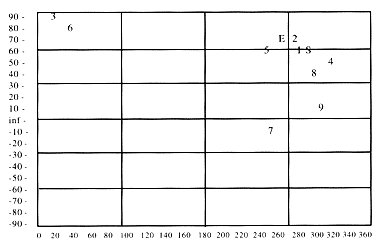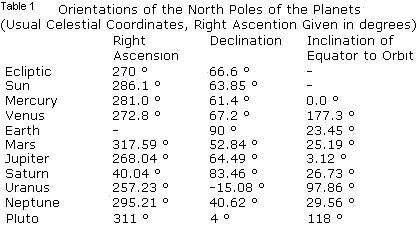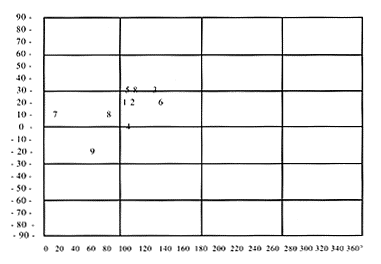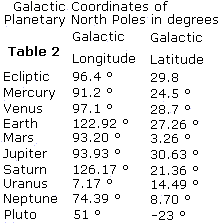## Celestial Motion (Part I): A Lawful Relationship Between the Rotation Of the Planets and the Galactic Plane, article in Journal of Orgonomy Volume 27 no. 1 http://www.orgonomy.org/article_145.html
EDITOR’S NOTE: The following article reports a lawful pattern in the rotational angles of the planets in our solar system. Dr. Harman’s discovery of this law is an entirely original finding in astronomy and provides additional concrete evidence of Reich’s discovery of a cosmic galactic stream of orgone energy. It also graphically illustrates how knowledge of orgone energy functions and the application of functional thinking can lead to new discoveries in the diverse realms of nature. P.A.C.
# Introduction: Using Reich’s astrophysical discoveries as a basis, it is possible to elucidate the relationships between different celestial motions. These relationships, though obvious once discovered, have eluded centuries of mechanistic research. In attempting to develop Reich’s conclusion that “the equatorial orgone envelope provides the concrete physical mover of the planets,” [1:81] it is shown that the directions of rotation of the sun and each of the nine planets are in simple functional relations to the galactic plane. This constitutes an advance over the mechanistic view, wherein there is no relationship whatsoever between the orientations of the planets relative to each other and no relationship between the directions of planetary rotation and other realms of celestial motion.
# Background: For millennia, man has sensed that the celestial bodies are in constant, lawful motion. Efforts have been made to understand these motions, first using animistic reasoning and later mechanistic and mystical thought.
Under current mechanistic theories, the motions of the solar system are traditionally viewed form a “frame of reference” in which the sun sits motionless at the center of the solar system and the planets revolve around the sun. In addition, the sun and each planet rotates (spins) on its own axis. For example, the Earth rotates on its axis (which is perpendicular to its equator) once a day and revolves around the sun once a year. The sun is one star that, along with tens of billions of other stars, is part of the Milky Way galaxy. The Milky Way is a disk with spiral arms that has a rotation of its own. The sun and the planets are believed to move through space as part of the general rotation of the galaxy.
The plane defined by the Earth’s equator is called the equatorial plane, the plane defined by the solar system is called the ecliptic plane, and the plane defined by the (flattened disk) of the galaxy is called the galactic plane. These three planes are oriented in different directions and mechanistic science is unaware of any lawful relationship between the three.
It is assumed that space is virtually empty and thus the motions of the celestial bodies occur without any significant friction. Thus, it is assumed that no force is necessary to continue the motions of the celestial bodies and that they can move in the same directions for billions of years with only relatively slight changes. The gross orientations of most celestial motions are assumed to have been set up in the distant past by factors which had little lawful relationship to each other (or were even accidental).
Reich discovered, however, that space is not empty but is filled with moving orgone energy. He discovered, through direct observation, that there is a stream of energy that circles the Earth from west to east. He called this the equatorial stream. Using observations of certain formations in the aurora Borealis, he deduced the existence of a second energy stream at 62 degree angle to the equatorial stream, which he called the galactic stream.
Reich’s research showed that there was a physical reality to the galactic and equatorial coordinate systems. Specifically, “the path of the sun on the ecliptic, which deviates from the equatorial plane by 23.5 degrees, thus appears as the resultant of the galactic and the equatorial orgone energy streams, with the latter constituting the slightly stronger force. . . The equatorial orgone envelope provides the concrete physical mover of the planets. The planets rotate on a north-south axis and are carried along like rolling balls on progressing water waves, slower than the waves. The sun does not “attract” the planets. It rolls along in the same plane and in the same direction, carried along with the planets in the equatorial orgone energy stream.” [1:81-82]
# Starting Point of Current Research: There are several unanswered questions about Reich’s original formulation:
1. The orientation of the Earth’s rotation appears to be local to the Earth and not a general phenomena for the other bodies in the solar system (see below). This is certainly the viewpoint of mechanistic science and orgonomy has, thus far, produced no data to contradict it. If the orientation of the equatorial stream is in fact local to the Earth, then attributing the motions of the sun and the other planets to it would constitute the functional error of mixing realms. If it were true that Reich made such an error, it could be viewed as analogous to regarding the Earth as the center of the solar system. If, on the other hand, Reich is correct, his conclusion is that the equatorial stream is the “concrete physical mover of the planets” is a great leap of functional thought. As such, it leaves numerous functional questions and details to be filled in.
2. Regardless of whether the “concrete physical mover of the planets” is oriented in the same direction as the Earth’s local equatorial stream, the stream that moves the planets must, of necessity, function in a larger realm than the Earth’s local stream. It must function throughout the solar system and the solar system’s path through the galaxy. Even if this larger stream (which can be designated as the SQ-Stream to distinguish from the Earth’s local equatorial stream) is in the plane of the Earth’s equator, this does not define its direction precisely. This stream could be directed in any direction along the 360-degree circle defined by the Earth’s equator.
3. Reich states that “each planet possesses a disk-line orgone energy envelope that rotates faster than the globe.” [1:96] In fact, direct observation of the sun and planets by telescopes and spacecraft shows atmospheric motion that implies the existence of such orgone energy streams (except for Mercury and Pluto). However, with one exception, the other planets do not rotate in even approximately the same orientation as the Earth. Mercury, Venus, Jupiter, and the Sun rotate approximately in the plane of the ecliptic at angles between 20 degrees and 30 degrees different from that of the Earth. Mars rotates in a completely different at a 40–degree inclination to the Earth’s rotation. Neptune rotates in yet another plane at a 50-degree angle to the Earth’s rotation. Pluto and Uranus rotate in directions almost perpendicular to the Earth. The case of Uranus is particularl6y unusual in that it rotates essentially perpendicular to the ecliptic. The orientations of the rotations of the planets and the sun are summarized below in Table 1. This shows the direction of each planet’s “north pole” (the pole, viewed from which a planet’s motion is counter-clockwise) expressed in celestial coordinates with right ascension converted to degrees. If the other planets move in such widely different angles from the earth, how can their motions be determined by the EQ-Stream?
4. Along the lines of #1, can the EQ-Stream be shown to have some relationship to a greater functional realm than the Earth and the solar system?
5. Stating that the galactic stream (which can be designated as the GA-Stream to distinguish it from the Earth’s local southwest energy stream) is at a 62-degree angle to the Earth’s equator does not precisely define its direction, but merely restricts it to a 62-degree cone oriented perpendicular to the equatorial plane.
6. Reich states that the planets move analogously to “rolling balls on progressing water waves.” However, the planets are moving, not on a two-dimensional surface, but through three-dimensional space. An energy stream encountering a planet in space would, upon encountering the obstacle posed by secondary matter, split into two streams on each side of the planet. (See Figure 1). Such a stream could give rise to motion in either of two opposite directions. A fundamental gap exists until we understand the functional relationships between these energy streams and the final direction of motion that is produced.

## page 2 of the article, from http://www.orgonomy.org/article_145p2.html
# The Relationship to the Galactic Plane: Viewed relative to the ecliptic or equatorial planes, the orientations of the planets vary widely (see Table I and Figure 2). There appears to be some sort of lawful pattern; for example, the Sun, Mercury, Venus, and Jupiter all rotate in approximately the ecliptic plane. The Earth, Mars, Saturn, and Neptune are all tilted at an approximately 25-degree angle to the ecliptic. The Earth and Saturn rotate in approximately the same orientation. However, mars and Neptune are oriented quite differently despite being at roughly the same angle to the ecliptic. Uranus and Pluto rotate in directions that do not seem similar to any of the other planets, although even here one has the impression that some lawful force is at work.

# Key:
Vertical = Declination Horizontal = Right Ascension (in degrees)
E = Ecliptic S = Sun 1 = Mercury
2 = Venus (S-Pole) 3 = Earth (RA-Arbitrary)
4 = Mars 5 = Jupiter 6 = Saturn
7 = Uranus 8 = Neptune 9 = Pluto
However, even though the relationship of the rotations to the ecliptic or equatorial plane appear numerically lawful in some unknown way, a functional relationship between them is not apparent. Particularly, it is not apparent how their motions could be in accord with Reich’s conclusions: (1) that “the equatorial orgone envelope provides the concrete physical mover of the planets” and (2) that the movements of the planetary system are the results of two energy streams.

In trying to understand if the rotations of the planets could be functional results of orgone energy streams, I tried to visualize, in three dimensions, how the planets were oriented relative to each other and the galaxy. To do so, I consulted the standard astronomical tables in reference books and visited museums and planetaria. This proved to be a frustrating task because all of the available tables, diagrams, models, etc. were oriented in the ecliptic plane in order to illustrate the mechanistic laws of planetary motion. This mechanistic portrayal of the universe supports the viewpoint that the universe consists of empty space filled with occasional pieces of dead matter moving according to mechanical laws.
In other words, the data is being presented in a way to convince one of an already formulated point of view rather than to enable one to simply observe and reach new conclusions. Nowhere could I find a model, diagram, or data designed to illustrate the relationship of the planets to the larger universe. Once cannot escape the feeling that some simple, natural viewpoint is being excluded.
As far as I could determine, straightforward observation of the relationship between planetary rotation and the larger universe had been excluded for hundreds of years from mechanistic natural science.
This limitation can be overcome by plotting the planetary orientations on a celestial globe and orienting it relative to the galactic plane (See Figure 3) or by tabulating the planetary rotations in galactic coordinates (See Table II).

# Key:
Vertical = Galactic Latitude Horizontal = Galactic Longitude
E = Ecliptic S = Sun 1 = Mercury
2 = Venus (S-Pole) 3 = Earth (RA-Arbitrary)
4 = Mars 5 = Jupiter 6 = Saturn
7 = Uranus 8 = Neptune 9 = Pluto

Looking at Table II, a striking relationship between planetary rotations and the galactic plane is evident. The orientations of the north poles of the ten bodies off the solar system are all within 30-degrees of the galactic plane. This relationship is shown in Figure 4. The odds of such a relationship occurring by chance are low (using the most reasonable assumptions*, something on the order of 128 to 1).
Actually, the significance of the planetary orientations is much stronger since all the planetary north poles, except Venus and Pluto, lie north of the galactic plane. The lawful significance of this (and the fact that Venus behaves lawfully as well) will be shown in a subsequent article.
Furthermore, such an orientation is consistent with Reich’s conclusions that the planets move like balls moved by water waves. It also gives rise to the new conclusion that those waves are on directions approximately parallel to the galactic plane.

Figure 4. Schematic illustration of angles between the planetary poles and the galactic and equaltorial planes.
This would mean that not only the GA-Stream, but also the EQ-Stream flows in the galactic plane. Since there is only one direction parallel to both the galactic and equatorial plane, this finding answers question #2 above, determining the three-dimensional orientation of the EQ-Stream for the first time. Based upon Reich’s study of the aurora and subsequent terrestrial observations of the equatorial and galactic streams (for example, satellite weather films) the angle between the two would be approximately 62-degrees.
# SUMMARY: It has been shown that there is a simple functional relationship between the orientations of planetary rotation and the galactic plane, namely the axes of rotation of the sun and the planets tend to be close to the galactic plane. This finding is consistent with the simplest and most natural application of Reich’s conclusion: namely that energy streams moving through and parallel to the galactic plane are responsible for planetary rotations and revolutions. As such it constitutes counter-evidence to the mechanistic assumption of “empty space.”
This finding is important because: (1) it demonstrates the reality of the energy streams flowing in the plane of the galaxy, and (2) it enables us to determine, based on physical observations, the three-dimensional orientation of at least one of these streams.
Article published by The American College of Orgonomy http://www.orgonomy.org/index.html